What Every Woman Needs to Know about Fertility Planning
You’ve probably heard that the number one tip to conceive is fertility timing. If you’re like most women, you probably find the phrase “fertility timing” a little confusing. Yet, fertility planning is important if you want to speed up the amount of time it takes you to conceive. This guide will take the intimidation out of the phrase “fertility timing” and will tell you how to find your “fertility window.”
What is Fertility Planning?
Fertility planning is when you track your ovulation patterns to find out when you’re most fertile.
Most women have menstrual cycles that are 28 days long; however, cycles can vary from about 21 to 35 days. You can only get pregnant about 6 of those days: the day your ovaries release an egg and the 5 days leading up to it. The few days you’re most fertile is called your “fertility window.” You have the best chances of getting pregnant if you have intercourse in the three days before ovulation. During this time, your chances of getting pregnant are up to 33%.
Calculating the Best Time to Conceive
There are two parts to figuring out the best days to have sex in order to conceive.
Part A: How to Track Your Cycle
To know your fertility window, you’ll need to track your menstrual cycle. It can be a bit confusing if you’ve never done it before — but don’t worry, we’re going to break it down for you.
Step 1
The first day of your cycle is the first day you get your period. Mark down on a physical or electronic calendar the first day you get your period.
Step 2
Mark down the first day of your period the following month. Do this for a few months to ensure you get an accurate idea. Since the length of your cycle can be longer one month and shorter the next, keeping track will allow you to find an average.
Step 3
For each month, count the days it took for your next period to arrive. If you waited 28 days on average for your next period, that means your cycle is 28 days.
Part B: How to Calculate Your Fertility Window
Now that you know the length of your cycle, you can determine your fertility window.
Step 1
Subtract 18 from the number of days of your shortest cycle (Ex. 28-18=10).
Step 2
Subtract 11 from the number of days of your longest cycle (ex. 30=11=19).
Step 3
Get busy! Having sex between these two dates in your cycle (ex. day 10 and 19) will give you the best chances. As we already mentioned, you are only fertile about 6 days of your cycle. However, if your cycle varies, it’s best to use this calculation to widen your fertility window, ensuring you don’t accidently miss a fertile day.
The Signs of Ovulation
Some women skip the tracking method and instead aim to become in tune with their body’s signs of ovulation.
Cervical Mucus
Before you ovulate, the mucus will be a whitish color. Even closer to or during ovulation, cervical mucus will change in color and texture. It will usually be clear and have the consistency of egg whites. Looking out for this change is an easy way to know when to have sex.
How to check: Each day you’re not menstruating, use a tissue to check your vaginal opening. Note the color and texture of the mucus and record it in a journal. When you record the changes each day, it will be easier to recognize the “egg white” mucus, which indicates the optimal time to conceive.
Basal Body Temperature (BBT)
Your body temperature stays about the same throughout your menstrual cycle, except during ovulation. Your BBT rises less than one degree during this time.
How to check: Take your temperature using a basal thermometer each morning before you get out of bed. Basal thermometers are available at most drugstores and can detect even the slightest changes in temperature, which is what you need. It’s important to do this around the same time each morning and before you have moved or consumed any liquids. Record your temperature each day. BTT will only tell you after you’ve ovulated, so it won’t help you predict when to have sex the first month. However, after a few months of recording your temperature, you may begin to see a pattern. That pattern could help you predict when you’re close to ovulating and when you’re most fertile.
Other Subtle Changes
If you become in tuned with your body, you may notice subtle changes during your fertility window:
• Increase in libido
• Breast tenderness
Keeping a Fertility Journal
Keeping a fertility journal is one of the best ways to increase your chances of getting pregnant. Purchase a journal that has enough space to record the changes you experience each day. This journal can be used to record everything mentioned above: your cycle, your fertility window, cervical mucus changes and BTT changes. You can also record other symptoms you may experience throughout your cycle. It may seem random at the time, but over a few months, you could begin to notice a pattern in how you feel before ovulation. These symptoms could be a sign that it’s time to get busy!
Should You Use Fertility Tracking Apps?
Instead of recording the old-fashioned way using a pen and paper, you may be tempted to use a fertility tracker app.
A recent study found that fertility tracker apps are “generally inaccurate.” Out of the more than 50 websites and apps studied, many included days after ovulation in the fertility window — when getting pregnant is very unlikely. On the bright side, every website and app correctly predicted at least a few days in the fertility window.
The verdict? If you’re in a rush to get pregnant, the old-fashioned tracking method might be best. But if you have patience, tracking apps could still be effective since they predict at least some days in the fertility window. Many apps and websites also give you the ability to journal. Instead of writing in a notebook or in a document on your computer, you will have a dedicated space to record changes your experience, such as cervical mucus production. Some apps also remind you to track these changes by sending out daily notifications.
If you do choose to use a fertility app or website, here are a few options:
BabyCenter Ovulation Calculator
This website 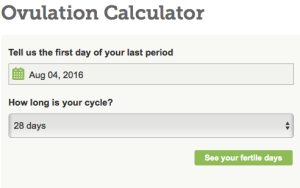 is a super simple tool that gets right down to the point. It requires you to input the first day of your last period and how long your cycle is. It will then calculate your most fertile days. To find out how long your cycle is, we recommend calculating that yourself to get an accurate average.
is a super simple tool that gets right down to the point. It requires you to input the first day of your last period and how long your cycle is. It will then calculate your most fertile days. To find out how long your cycle is, we recommend calculating that yourself to get an accurate average.
Ladytimer
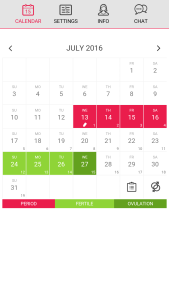 available in both the App Store and Google Play Store, can help you predict your menstrual cycle, which will help you predict your fertility window. It also has an ovulation calculator with a cervical mucus tracker.
available in both the App Store and Google Play Store, can help you predict your menstrual cycle, which will help you predict your fertility window. It also has an ovulation calculator with a cervical mucus tracker.
Free Menstrual Calendar
The Free Menstrual Calendar is an app available in the 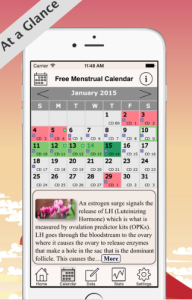 App Store that tracks your period and can calculate your usual cycle length, which you need to determine the optimal days to conceive. You can also record when you have sex, cervical fluid and your temperature — all of which are helpful in fertility timing.
App Store that tracks your period and can calculate your usual cycle length, which you need to determine the optimal days to conceive. You can also record when you have sex, cervical fluid and your temperature — all of which are helpful in fertility timing.
Kindara
Kindara is a fertility app that focuses on monitoring yo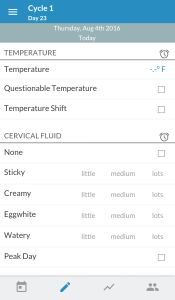 ur basal body temperature and cervical mucus. From this information, the app will tell you the best time to conceive. The app works with a thermometer called Wink, which automatically syncs to the app. It is available in both the App Store and Google Play Store.
ur basal body temperature and cervical mucus. From this information, the app will tell you the best time to conceive. The app works with a thermometer called Wink, which automatically syncs to the app. It is available in both the App Store and Google Play Store.
Fertility Friend
Fertility Friend is an advanced ovulation ca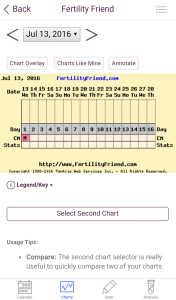 lendar that can give you a more in-depth look at your cycle. The app is free in both the App Store and Google Play store; however, the paid version gives you access to even more advanced features. When you become a VIP member, you can also use their message boards, which can be a great way to connect with women who are going through the same experiencing as you.
lendar that can give you a more in-depth look at your cycle. The app is free in both the App Store and Google Play store; however, the paid version gives you access to even more advanced features. When you become a VIP member, you can also use their message boards, which can be a great way to connect with women who are going through the same experiencing as you.
SCREENSHOT
Get Down to Business
Whether you’ve determined your fertility window the old-fashioned way or through an app, it’s time to get busy! It’s simple: the more sex you have during this period, the more likely it is that you will get pregnant. When we say get busy, we mean get really busy! Try to have sex every day during your fertility window. If that’s not possible, have sex every other day during this time.
Some women may worry that having sex too much will decrease their partner’s sperm count. However, that’s not true. Your partner should create new sperm daily.
Remember that pregnancy doesn’t always happen quickly. Fertility planning is about understanding your body’s patterns and working in harmony with them. To find your body’s pattern, it’s going to take more than a month. A minimum of three months of tracking is required to get an accurate measure. Even if you track each month with 100% accuracy and have sex every day during your fertility window, it could still take more than a few months to get pregnant. This is normal and does not mean you’re infertile.
So, when is it time to consult your doctor? If you’ve been actively trying to conceive for 12 months with no success and are under 35, you should consider fertility tests.
Want to speed up conception? Check out 11 other tips to increase your fertility.
Have you ever tracked your cycle to find your fertility window? If you have, comment below and tell us how it went. If this article finally helped you understand fertility planning, share it to help others too!
Resources:
http://www.babycenter.com/chart-basal-body-temperature-and-cervical-mucus
http://www.webmd.com/baby/charting-your-fertility-cycle#2
http://attainfertility.com/article/fertility-tracking-ovulation
http://www.huffingtonpost.com/entry/study-reveals-fertility-tracker-apps-are-generally-inaccurate_us_575aed92e4b00f97fba8252d




1 comment
[…] Stress can also cause you to ovulate later in your cycle, meaning you’ll misjudge your “fertility window.” […]